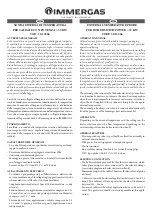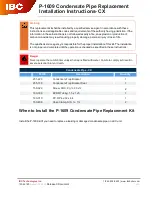
750-136
Model WB Electric Boiler Manual
4-5
4.3 — Element Replacement Procedure
4.2.3 — Annual Procedure
The boiler should be drained and cleaned to remove any accumulated scale or sludge. This normally can be done
concurrently with an annual inspection. More frequent cleaning may be required if the boiler supply water con-
tains sediment or if a considerable amount of make-up water is used to replace system losses. The annual check-
out and start-up procedure is otherwise identical with the aforementioned monthly and quarterly procedure.
4.3 — Element Replacement Procedure
4.3.1 — Heating Elements
The smaller, individually replaceable Cleaver-Brooks electric heating elements are readily accessible for fast,
easy, on-the-job maintenance. They can be removed and replaced with standard tools. The small physical size of
each element means the element bundle is lighter and simpler to remove.
4.3.2 — Element Replacement
1.
Make a sketch or a drawing of the element bussing and tag the wires to simplify re-connection later. Refer to
the wiring diagram supplied by Cleaver-Brooks for your installation.
2.
Disconnect the wires and remove the element assembly flange bolts.
3.
Remove the element assembly by pulling it straight out.
4.
Remove the jumper wires and remove the brass ferrule nuts.
5.
Slide the element toward the dry side (about 2”) to expose the brass ferrules on the element. Cut off the fer-
rules with a hacksaw. Slide the element out of the steel flange toward the wet side.
6.
Inspect and clean the thread and the seat of the steel flange where the new ferrules will seal. If seats are pit-
ted or rusted, it may not be possible to seal the new elements; therefore, a new flange may be required.
7.
Screw the new ferrule nuts (furnished with a replacement element) into the cleaned or new flange plate (finger
tight).
8.
Slide the element into position. Make sure the element protrudes beyond the ferrule nut approximately 1/4”,
or to match original assembly. Some boiler models require the element sheath to extend out further than 1/4”,
so duplicate the original assembly as closely as possible.
9.
Hold the element to prevent twisting while tightening the ferrule nuts. Tighten the nuts to approximately 45 ft.
lbs. (35 ft. lbs. for 208 and 240 volt elements). You will feel the ferrule separate from the nut while tighten-
ing. A properly tightened ferrule nut will have separated from its ferrule and the ferrule will be squeezed or
compressed onto the element sheath, thus providing a tight seal.
Before element replacement, make certain the boiler is drained below the element opening and lock out and discon-
nect the boiler’s main power to avoid the hazard of electrical shock, which could result in serious personal injury or
death.
NOTE:
To assist in breaking free the gasket, insert one of the flange bolts into the tapped hole provided.
NOTE:
Since the elements often differ in length, check to assure that there is an adequate clearance (3/4” min.)
between the end of the element and the opposite side vessel wall. Check by measuring both the element extension
(from flange to tip) and the distance from the tank flange face to the vessel wall.
!
Warning
Содержание WB
Страница 1: ...Table Of Contents Model WB Electric Boilers Hot Water Operation and Maintenance Manual 750 136 07 2018...
Страница 2: ......
Страница 6: ......
Страница 12: ...General Description 1 6 750 136 Model WB Electric Boiler Manual...
Страница 18: ...Installation Instructions 2 6 750 136 Model WB Electric Boiler Manual...
Страница 35: ......
Страница 36: ......










































